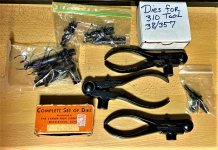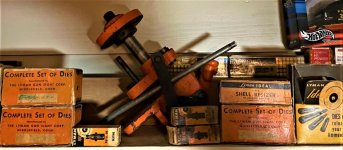Hello friends,
I’m afraid I might need to put my dreams of reloading at the range on hold. Here are the results, 7-yards offhand at a 3” shoot-n-see.
The flyer is mine. More tearing than I would like, but 3.2 grains of W-231 doesn’t exactly produce a speedy projectile.
The problem is that the rounds were a bear to chamber, to the point where some wouldn’t seat all the way, leading to headspace issues. Rounds dropped more easily into some chambers than others, leading me to think that this is the result of slightly different chamber specs and not resizing the brass. I tested chambering later with some factory rounds and they slipped right in. I’ll thoroughly clean the chambers later in case they’re just grimy, but I might hold off using the tool again until I acquire a .32-20 firearm with one chamber instead of six.




